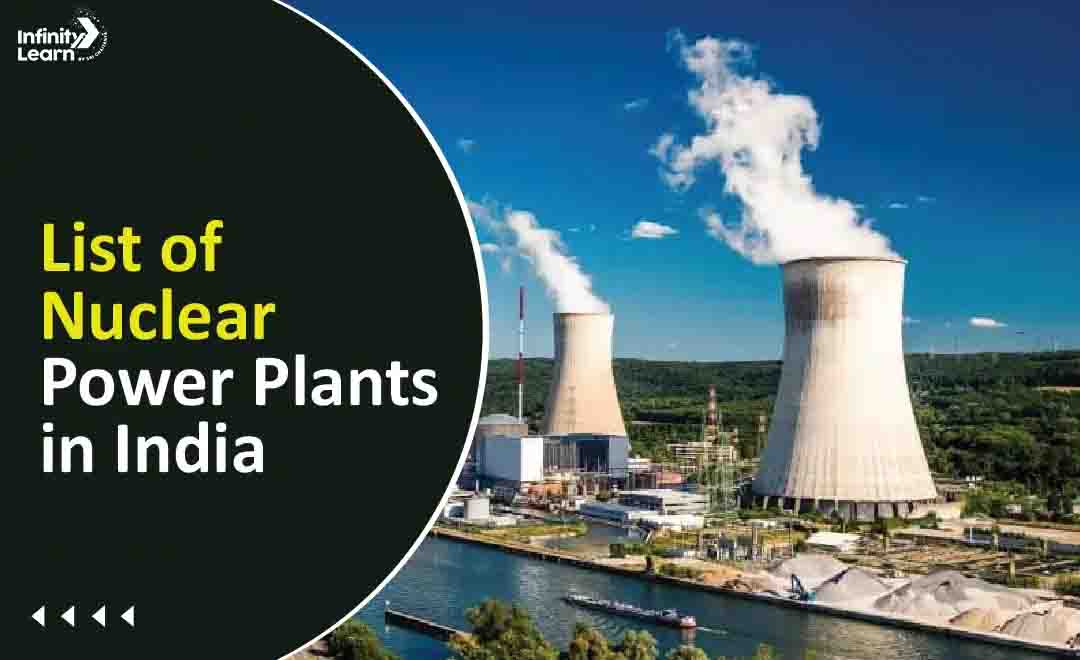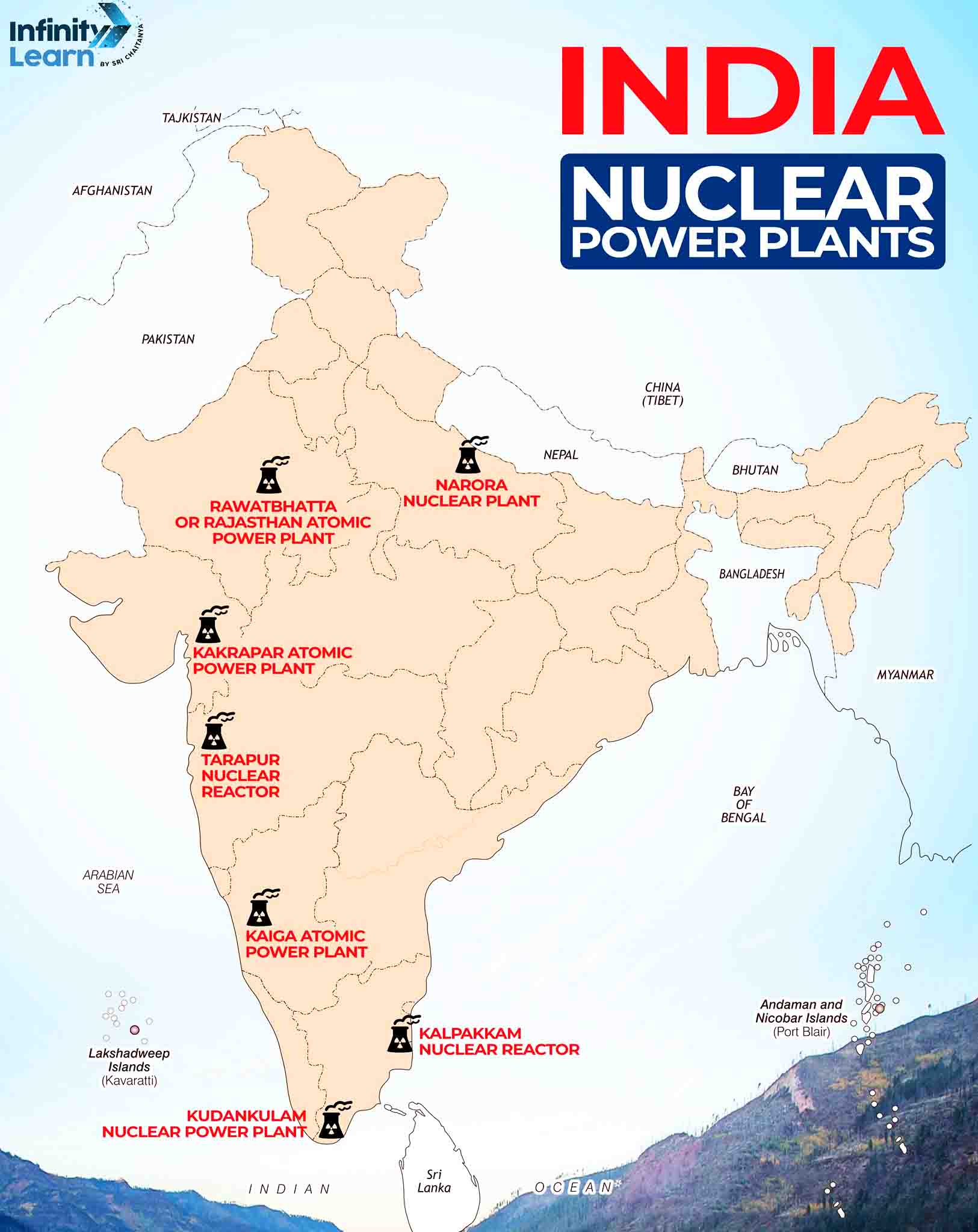Table of Contents
Nuclear Power Plant in India: Nuclear power plays a crucial role in India’s energy sector, providing a significant portion of the country’s electricity. As we move through 2024, understanding the landscape of nuclear power plants (NPPs) in India is essential. This blog covers key aspects including a list of current and planned nuclear power stations, state-wise distribution, the largest facilities, and more.

What is Nuclear Power Plant in India
A nuclear power plant is a facility where nuclear energy is used to generate electricity. This process involves harnessing the energy released from nuclear fission reactions, where atomic nuclei split into smaller parts. Fuel rods made of uranium or plutonium fission inside nuclear reactors release a lot of heat. This thermal energy produces steam, which drives generator-connected turbines to produce electricity. Because they offer a low-carbon substitute for fossil fuels and are essential for meeting energy demands while lowering greenhouse gas emissions, nuclear power plants are built to supply energy on a large and consistent scale. India currently operates 22 nuclear power reactors with a combined installed capacity of 6,780 MW. Additionally, there are 8 reactors under construction, including the 500 MW Prototype Fast Breeder Reactor (PFBR) being developed by BHAVINI, which will add a total of 6,000 MW to the country’s nuclear power capacity.
Also Check: Solar Power Plant
How Many Nuclear Power Plant in India
As of November 2020, India operates eight nuclear power plants with 23 active reactors, providing a combined installed capacity of 7,380 megawatts (MW). By 2024, India plans to expand this number to nine operational nuclear power plants. Nuclear energy ranks as the fifth-largest electricity source in the country, following coal, gas, hydroelectric, and wind power. In the fiscal year 2020–21, nuclear power generated 43 terawatt-hours (TWh), which constituted 3.11% of India’s total electricity output.
Key Facts About Nuclear Power in India
- Fifth-Largest Electricity Source: Nuclear power stands as the fifth-largest contributor to India’s electricity supply, following thermal, hydroelectric, and renewable energy sources.
- Operational Reactors: India has 22 nuclear power reactors currently in operation, spread across 7 states.
- Installed Capacity: These reactors have a combined installed capacity of 6,780 Megawatts electric (MWe).
- Reactor Types: Out of these, 18 reactors are Pressurised Heavy Water Reactors (PHWRs), while 4 are Light Water Reactors (LWRs).
- Regulatory Body: The nation’s nuclear power generation is overseen by the Mumbai-based Nuclear Power Corporation of India Limited (NPCIL). NPCIL is a company that the government owns.
- Administrative Oversight: NPCIL operates under the supervision of the Department of Atomic Energy, which is part of the Government of India.
List of Nuclear Power Plant in India for 2024
Understanding the distribution of nuclear power plants across India is crucial for appreciating the country’s energy landscape. “Nuclear Power Plants in India State-Wise” offers insights into the geographic locations and capacities of these facilities, highlighting their role in India’s energy strategy. This breakdown of states shows how nuclear power affects the availability of electricity in different parts of India. India has multiple nuclear power plants operating throughout the nation as of 2024. This is a comprehensive list of these amenities:
Operational Nuclear Power Plants in India
| Name of Nuclear Power Station | Location | Operator | Capacity (MW) |
| Kakrapar Atomic Power Station (1993) | Gujarat | NPCIL | 440 |
| (Kalpakkam) Madras Atomic Power Station (1984) | Tamil Nadu | NPCIL | 440 |
| Narora Atomic Power Station (1991) | Uttar Pradesh | NPCIL | 440 |
| Kaiga Nuclear Power Plant (2000) | Karnataka | NPCIL | 880 |
| Rajasthan Atomic Power Station (1973) | Rajasthan | NPCIL | 1,180 |
| Tarapur Atomic Power Station (1969) | Maharashtra | NPCIL | 1,400 |
| Kudankulam Nuclear Power Plant (2013) | Tamil Nadu | NPCIL | 2,000 |
Planned Nuclear Power Plant in India: Future Projects
Here is a comprehensive list of upcoming nuclear power plants in India, showcasing future developments and their expected capacities:
| Name of Nuclear Power Station | Location | Capacity (MW) |
| Tarapur | Maharashtra | 300 |
| Madras | Tamil Nadu | 1,200 |
| Kaiga | Karnataka | 1,400 |
| Chutka | Madhya Pradesh | 1,400 |
| Gorakhpur | Haryana | 2,800 |
| Bhimpur | Madhya Pradesh | 2,800 |
| Mahi Banswara | Rajasthan | 2,800 |
| Haripur | West Bengal | 4,000 |
| Mithi Virdi (Viradi) | Gujarat | 6,000 |
| Kovvada | Andhra Pradesh | 6,600 |
| Jaitapur | Maharashtra | 9,900 |
Largest Nuclear Power Plant in India
The Kudankulam Nuclear Power Plant (KKNPP), located in Tamil Nadu, is recognized as the largest nuclear power facility in India in terms of its total capacity. On March 31, 2002, work on the Kudankulam Nuclear Power Plant (KKNPP) began. Despite facing delays primarily due to opposition from local fishermen concerned about environmental impacts, the plant has progressed significantly.
As of February 2019, KKNPP had an installed capacity of 2,000 Megawatts (MW) with its initial reactors operational. In addition, another 2,000 MW capacity is under development with future expansions planned to further bolster its contribution to the national grid. The plant utilizes advanced Russian VVER-1000 reactors, known for their safety and efficiency.
KKNPP’s strategic location near the southern coast of India makes it crucial for meeting the energy needs of the region, which is economically vital and densely populated. The facility plays a key role in India’s energy strategy by providing a stable, low-carbon energy source, thus supporting the country’s goals for sustainable development and reduced greenhouse gas emissions.
Nuclear Power Plant in India Map
A visual representation of nuclear power plants in India can be highly informative. A map highlighting the locations of these plants helps in understanding their geographic distribution.

List of Nuclear Power Plant in India Download PDF
For those looking for a comprehensive and printable resource, many official sources provide lists of nuclear power plants in India in PDF format. This can be useful for academic, professional, or personal reference. Download the PDF list here – List of Nuclear Power Plant PDF
Top 10 Nuclear Power Plants in India
Here’s a list of the top 10 nuclear power plants in India based on their capacity and significance:
- Rajasthan Atomic Power Station (RAPS)
- Tarapur Atomic Power Station (TAPS)
- Kakrapar Atomic Power Station (KAPS)
- Kaiga Generating Station
- Neyveli New Thermal Power Station (NNPS)
- Kalpakkam Nuclear Power Complex
- Kudankulam Nuclear Power Plant
- Chennai Nuclear Power Station
- Jaitapur Nuclear Power Plant
- Bhimpur Nuclear Power Plant
MCQ Based Questions on Nuclear Power Plant in India
1. What is the main type of fuel utilized in nuclear power plants in India?
a) Uranium
b) Thorium
c) Plutonium
d) Coal
Answer: a) Uranium
2. Which Indian nuclear power plant is known as the first commercial nuclear power plant in India?
a) Tarapur
b) Kudankulam
c) Narora
d) Kaiga
Answer: a) Tarapur
3. Which state is the location of the Kudankulam Nuclear Power Plant?
a) Tamil Nadu
b) Maharashtra
c) Gujarat
d) Andhra Pradesh
Answer: a) Tamil Nadu
4. Which Indian nuclear power plant is operated by the Nuclear Power Corporation of India Limited (NPCIL) and has the highest number of reactors?
a) Tarapur
b) Kalpakkam
c) Kakrapar
d) Rawatbhata
Answer: a) Tarapur
5. What is the main goal of India’s Three-Stage Nuclear Power Programme?
a) To develop commercial nuclear power
b) To achieve nuclear weapons capability
c) To use thorium as a fuel
d) To increase uranium mining
Answer: c) To use thorium as a fuel
6. Which nuclear power plant in India is equipped with a Fast Breeder Reactor (FBR)?
a) Narora
b) Kalpakkam
c) Tarapur
d) Kakrapar
Answer: b) Kalpakkam
7. The Narora Nuclear Power Plant is located in which Indian state?
a) Uttar Pradesh
b) West Bengal
c) Rajasthan
d) Punjab
Answer: a) Uttar Pradesh
8. The Bhadrak Nuclear Power Plant is a part of which nuclear project?
a) Indian Fast Breeder Reactor Program
b) Thorium-based Reactor Program
c) Pressurized Heavy Water Reactor Program
d) Light Water Reactor Program
Answer: c) Pressurized Heavy Water Reactor Program
Nuclear Power Plant in India FAQs
Where are the 7 nuclear power stations in India?
India has several nuclear power stations spread across different states. The seven key nuclear power stations are: Tarapur Nuclear Power Station in Maharashtra Kudankulam Nuclear Power Plant in Tamil Nadu Narora Atomic Power Station in Uttar Pradesh Kalpakkam Nuclear Power Plant in Tamil Nadu Kakrapar Atomic Power Station in Gujarat Rawatbhata Nuclear Power Plant in Rajasthan Kaiga Atomic Power Station in Karnataka
How many nuclear power plants are there in India currently?
As of now, India has 22 operational nuclear reactors.
Which is the largest nuclear power plant in India?
With a combined capacity of 2,000 MW (1,000 MW from each of its two reactors), the Kudankulam Nuclear Power facility is the largest nuclear power facility in India.
Which is the latest nuclear power plant in India?
On February 20, 2024, Unit 4 of the Kakrapar Nuclear Power Plant was successfully linked to the grid, according to a statement released by the Nuclear Power Corporation of India Ltd. (NPCIL). On December 17, 2023, this 700 MWe pressurized heavy water reactor achieved its initial criticality.









